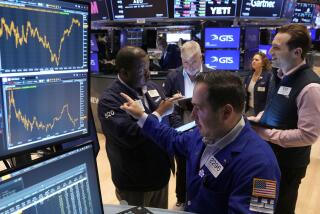Bernanke has a rescue plan, but can he get markets to go along?
Federal Reserve Chairman Ben S. Bernanke made clear Friday that heâs committed to keeping long-term interest rates suppressed.
Now, if only the bond market would get the message.
Long-term rates havenât followed the Fedâs instructions since the central bank on Nov. 3 announced its plan to ramp up Treasury bond purchases by $600 billion through mid-2011.
Interest rates are up, not down. In some cases, theyâre up dramatically. This week, yields in the municipal bond market rocketed to their highest levels by some measures in more than a year.
Even the Treasury market itself seems disbelieving of the Fedâs power to push rates any lower, despite the fact that the central bank already is aggressively buying government securities every day.
The yield on the 10-year Treasury note, a benchmark for long-term rates in general, rose as high as 2.91% early in the week, a three-month high. The yield ended Friday at 2.87%, nearly a half-percentage-point above the low of 2.39% reached in October.
The jump in the T-noteâs yield has pulled up mortgage rates, with the average rate on a 30-year home loan hitting 4.39% this week, the highest since mid-August. The only jobs that rising mortgage rates will create are in bank foreclosure departments.
But at the moment, none of this seems ruinous for the economy. Mortgage rates, for example, still are well below their 2010 peak of 5.21% set in early April.
There is a good argument that the whiplash in interest rates this month is just a classic case of âbuy on the rumor, sell on the newsâ: Yields on longer-term Treasuries and other securities had tumbled in September and October, as investors bet that the Fed would launch a substantial new bond-buying program.
Once the Fed met those expectations it was inevitable that some investors, figuring yields werenât going any lower, would bail out of bonds.
The municipal bond market has been hit particularly hard, but thatâs partly a function of the huge supply of new debt being sold this month, including $14 billion from the state of California. Many investors have simply stepped away to see how high yields might go. By Thursday there were signs that buyers were returning to the muni market to snap up richer returns.
Still, whatever the excuse for the backup in interest rates this month, the trend is no help to the Fedâs agenda. Bernanke says that the U.S. economy needs lower rates and that he wants to deliver them. In buying massive amounts of Treasury bonds, the central goal is to hold down market yields on those securities and thus suppress other long-term rates.
Bernanke reportedly told Republican leaders Monday that his program could create 700,000 jobs over the next two years by bolstering economic growth.
But if he canât keep rates down and the economy fails to pick up speed, Bernanke will be pilloried. The $600-billion program will be remembered as Benâs Folly.
The plan already has attracted a growing army of opponents. Germany, China and other U.S. trading partners have said it will fuel inflation by flooding the world with more dollars that the Fed is creating from thin air to buy bonds. The criticism also stems from national self-interest: Trading rivals see the program as a way to give U.S. exporters an advantage by further depressing the dollar.
Some GOP leaders also have attacked the plan as reckless money-printing.
But if Bernankeâs critics thought he might back down, they misjudged him. He clearly knows that Fed policy has become a political issue, yet he has been willing to further politicize the debate while publicly taking on his critics.
In a speech in Germany on Friday, Bernanke donned a populist mantle in defending the bond-purchase plan as a way to lift the economy.
âOn its current economic trajectory, the U.S. runs the risk of seeing millions of workers unemployed or underemployed for many years,â he said. âAs a society, we should find that outcome unacceptable.â
Try to imagine those words coming from Bernanke predecessor and Ayn Rand devotee Alan Greenspan.
The Fed has insisted it will pursue its bond-buying plan only as long as itâs necessary. Should the economy show sustained strength, Bernanke has said, the Fed will back off.
At that point, the assumption is that interest rates would rise because a real recovery was taking hold, boosting demand for money. Under those circumstances the Fed would be expected to allow long-term rates to find their natural level.
Lately the economic data have been mixed, though mostly more upbeat than two months ago. That obviously isnât good enough for the Fed; its Treasury-buying program is in high gear.
Now, Bernanke needs the markets to follow along. He needs bond yields to pull back and, for good measure, the stock market to resume its rally after the hiccup of the last two weeks.
If we get into early next year and long-term interest rates are higher instead of lower, without any further improvement in the economy, the publicâs reaction may mirror what the Fed is getting in spades from the GOP and other critics: Youâre spending all of that made-up money, and it isnât working.
The Fedâs credibility is on the line, perhaps as never before. Without credibility, a central bank has nothing.
More to Read
Inside the business of entertainment
The Wide Shot brings you news, analysis and insights on everything from streaming wars to production â and what it all means for the future.
You may occasionally receive promotional content from the Los Angeles Times.










